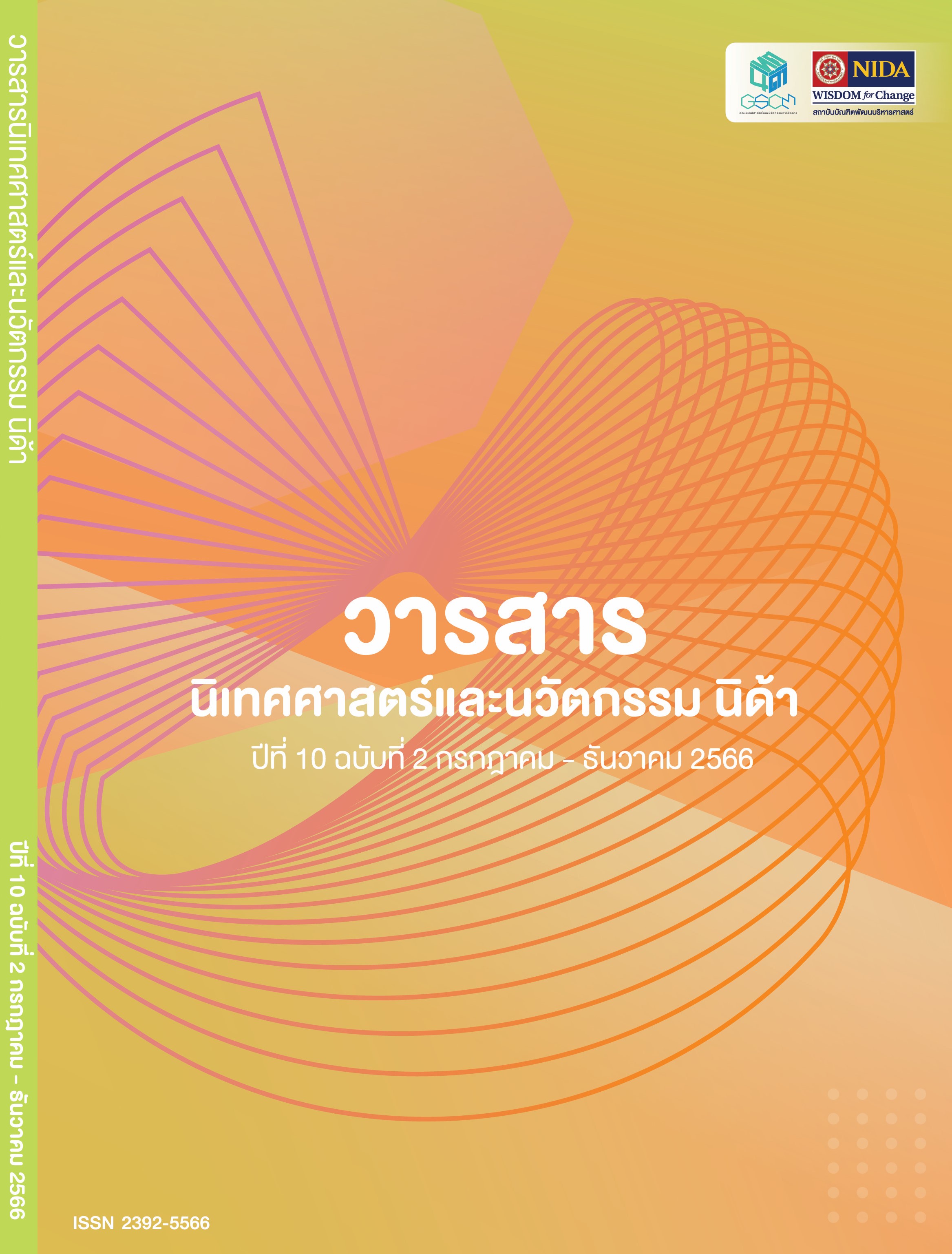Communication to Increase Efficiency for Social Media Literacy toward Preventing the Spread of Coronavirus for Undergraduate’s Students in Phitsanulok Province
Main Article Content
Abstract
The purposes of this research were to study: 1) the factors affecting social media literacy towards preventing the spread of Coronavirus for undergraduate students in Phitsanulok province; and 2) the communication methods to increase the efficiency of social media literacy towards preventing the spread of Coronavirus for undergraduate students in Phitsanulok province.
This study is quantitative research, in which the data is collected through in-depth interviews and a focus group of fifteen samples.
The findings indicated that factors influencing social media literacy in preventing the spread of coronavirus among undergraduate students encompassed demographic characteristics, proficiency in social media skills, behavior related to social media exposure, and social media literacy. The skills for enhancing social media literacy in the context of preventing coronavirus transmission were identified, including accessing information on social media, analyzing information from social media, evaluating media content on social platforms, creating content on social media, and actively participating in disseminating information through social media. Furthermore, communication guidelines to enhance the effectiveness of the social media literacy model in preventing coronavirus transmission comprise family, university, collaboration between the government and the private sector, and social media use among students.
Article Details

This work is licensed under a Creative Commons Attribution-NonCommercial-NoDerivatives 4.0 International License.
ข้อความและความเห็นในวารสารนิเทศศาสตร์และนวัตกรรม นิด้า เป็นของผู้เขียนแต่ละท่าน มิใช่ของคณะนิเทศศาสตร์และนวัตกรรมการจัดการ สถาบันบัณฑิตพัฒนบริหารศาสตร์
References
กรมควบคุมโรค. กระทรวงสาธารณสุข. (2563). คู่มือการป้องกันและควบคุมโรคติดเชื้อไวรัสโคโรนา 2019 สำหรับประชาชน. โรงพิมพ์ชุมนุมสหกรณ์การเกษตรแห่งประเทศไทย จำกัด.
กันยารัตน์ อุบลวรรณ, นัยนา ภูลม, จีราภรณ์ ชื่นฉ่ำ และวิยะการ แสงหัวช้าง. (2566). การรู้เท่าทันสื่อเกี่ยวกับการระบาดของเชื้อไวรัสโคโรนา สายพันธุ์ใหม่ (COVID-19) ของนักศึกษาระดับปริญญาตรีของสถาบันพระบรมราชชนก. วารสารศูนย์อนามัยที่ 9, 17(1), 354-367. https://he02.tci-thaijo.org/index.php/RHPC9Journal/article/view/260907
จินตนา ตันสุวรรณนนท์, ปิ่นกนก วงศ์ปิ่นเพ็ชร์ และชัญญา ลี้ศัตรูพ่าย.. (2553). ปัจจัยที่เกี่ยวข้องกับพฤติกรรมการบริโภคสื่อด้วยปัญญาของนักศึกษาระดับอุดมศึกษาในเขตกรุงเทพมหานคร. วารสารพฤติกรรมศาสตร์ (มหาวิทยาลัยศรีนครินทรวิโรฒ), 16(1), 122-135. https://so06.tci-thaijo.org/index.php/BSRI/article/view/504/448
จุฬารัตน์ บุษบงก์. (2561). การพัฒนารูปแบบการรู้เท่าทันสื่อในศตวรรษที่ 21 ของนักศึกษาระดับปริญญาตรี. โครงการวิจัยทุนอุดหนุนมหาวิทยาลัยราชภัฏศรีสะเกษ มหาวิทยาลัยราชภัฏศรีสะเกษ. https://tdc.thailis.or.th/tdc/dccheck.php?Int_code=41&RecId=1322&obj_id=3773&showmenu=no
ณัฐนันท์ ศิริเจริญ. (2557). การสื่อสารเพื่อการรู้เท่าทันสื่อและสารสนเทศจากสื่ออินเทอร์เน็ตของ นักศึกษาระดับปริญญาตรี (วิทยานิพนธ์ปริญญานิเทศศาสตรดุษฎีบัณฑิต ไม่ได้ตีพิมพ์). มหาวิทยาลัยสุโขทัยธรรมาธิราช. https://doi.nrct.go.th/ListDoi/listDetail?Resolve_DOI=10.14457/STOU.the.2014.4
ปรมะ สตะเวทิน. (2546). หลักนิเทศศาสตร์. ห้างหุ้นส่วนจำกัด ภาพการพิมพ์.
พัชราภา เอื้ออมรวนิช. (2565). โควิด 19 กับการรู้เท่าทันการแพร่ระบาดของข่าวสารในสื่อสังคมออนไลน์. วารสารสถาบันวิจัยและพัฒนามหาวิทยาลัยราชภัฏบ้านสมเด็จเจ้าพระยา, 6(2), 29-36. https://so06.tci-thaijo.org/index.php/rdibsru/article/view/254217
พิชญา สกุลวิทย์, อังคณา อ่อนธานี และจักรกฤษณ์ จันทะคุณ. (2564). การออกแบบการสื่อสารในรูปแบบวิถีใหม่. วารสารวิชาการคณะมนุษยศาสตร์และสังคมศาสตร์ มหาวิทยาลัยราชภัฏเทพสตรี, 12(3), 127-138. https://so01.tci-thaijo.org/index.php/truhusocjo/article/view/247322/169410
พีระ จิระโสภณ, ทัณฑกานต์ ดวงรัตน, มนต์ ขอเจริญ, ชนัญสรา อรนพ ณ อยุธยา, อุษา รุ่งโรจน์การค้า, โสภัทร นาสวัสดิ์ และณัทธสิฐษิ์ สิริปัญญาธนกิจ. (2559). ความรู้เท่าทันการสื่อสารยุคดิจิทัลกับบทบาทในการกำหนดแนวทางการปฏิรูปการสื่อสารในสังคมไทย. รายงานการวิจัย มหาวิทยาลัยธุรกิจบัณฑิตย์. https://libdoc.dpu.ac.th/research/159568.pdf
ภาสกร จิตรใคร่ครวญ. (2553). เทคโนโลยีของสื่อใหม่และการนำเสนอตัวตนต่อสังคมกับพฤติกรรมการสื่อสารบนเครือข่ายสังคมออนไลน์ (วิทยานิพนธ์นิเทศศาสตรมหาบัณฑิต ไม่ได้ตีพิมพ์). จุฬาลงกรณ์มหาวิทยาลัย. https://doi.nrct.go.th/ListDoi/listDetail?Resolve_DOI=10.14457/CU.the.2010.519
เมธาวี จำเนียร. (2564). การเรียนการสอนเพื่อส่งเสริมสุขภาวะเยาวชนในสถานการณ์การแพร่ระบาดของโรคโควิด-19. วารสารวิชาการมหาวิทยาลัยนอร์ทกรุงเทพ, 10(2), 1-9. https://so01.tci-thaijo.org/index.php/NBU/article/view/247619
รุจิกาญจน์ ธนาเศรษฐ์สุนทร . (2561). การรู้เท่าทันสื่อใหม่ของนักเรียนระดับมัธยมปลายในเขตอำเภอลานกระบือ จังหวัดกำแพงเพชร (วิทยานิพนธ์ปริญญานิเทศศาสตรมหาบัณฑิต ไม่ได้ตีพิมพ์). มหาวิทยาลัยนเรศวร. https://tdc.thailis.or.th/tdc/dccheck.php?Int_code=94&RecId=9449&obj_id=89614&showmenu=no
ศุภกร จูฑะพล และบุหงา ชัยสุวรรณ. (2559). ทัศนคติต่อการดำเนินชีวิต พฤติกรรมการดำเนินชีวิตและความคล่องดิจิทัลของกลุ่มดิจิทัลเนทีฟ. วารสารวิชาการมนุษยศาสตร์และสังคมศาสตร์, 24(2), 313-329. https://so06.tci-thaijo.org/index.php/husojournal/article/view/68667/55919
ศูนย์ต่อต้านข่าวปลอม ประเทศไทย. (31 พฤษภาคม 2565). ข่าวปลอม อย่าแชร์! หน้ากากอนามัยที่ไม่ระบุ VFE จะไม่สามารถป้องกันไวรัสได้. Anti-Fake News Center Thailand. https://www.antifakenewscenter.com/ผลิตภัณฑ์สุขภาพ/ข่าวปลอม-อย่าแชร์-หน้าก-3/
การสํารวจพฤติกรรมผู้ใช้อินเทอร์เน็ตในประเทศไทย ปี 2565. สำนักงานพัฒนาธุรกรรมทางอิเล็กทรอนิกส์. https://www.etda.or.th/getattachment/78750426-4a58-4c36-85d3-d1c11c3db1f3/IUB-65-Final.pdf.aspx
สรานนท์ อินทนนท์. (2562). รู้เท่าทันข่าว. มูลนิธิส่งเสริมสื่อเด็กและวัยรุ่น.
สุภารักษ์ จูตระกูล. (2559). ครอบครัวกับการรู้เท่าทันสื่อดิจิทัลของดิจิทัลเนทีฟ. วารสารวิทยาการจัดการ มหาวิทยาลัยราชภัฎเชียงราย, 11(1), 99-118. http://jms.crru.ac.th/datas/MJ_36_1_2559.pdf
สุภิญญา กลางณรงค์ และณภัทร เรืองนภากุล. (18 เมษายน 2564). ความเป็นพลเมืองยุคดิจิทัลกับการรับมือด้านมืดออนไลน์ในวิถีปรกติใหม่. Cofact (โคแฟค). https://blog.cofact.org/digitalcitizen/
สำนักงานคณะกรรมการกิจการกระจายเสียง กิจการโทรทัศน์ และกิจการโทรคมนาคมแห่งชาติ (2556). 100 เรื่องน่ารู้ ผู้บริโภคสื่อวิทยุ-โทรทัศน์. สำนักงานคณะกรรมการกิจการกระจายเสียง กิจการโทรทัศน์ และกิจการโทรคมนาคมแห่งชาติ.
สำนักงานพัฒนาธุรกรรมทางอิเล็กทรอนิกส์ ETDA. (9 เมษายน 2564). ETDA เผยผลสำรวจ IUB 63 คนไทยใช้เน็ตปังไม่ไหว เกือบครึ่งวัน โควิด-19 มีส่วน. สำนักงานพัฒนาธุรกรรมทางอิเล็กทรอนิกส์. https://www.etda.or.th/th/newsevents/pr-news/ETDA-released-IUB-2020.aspx
สํานักงานสถิติแห่งชาติ, (31 พฤษภาคม 256๖). การสำรวจการมีการใช้เทคโนโลยีสารสนเทศและการสื่อสารในครัวเรือน ปีพ.ศ.2563. สำนักงานสถิติแห่งชาติ. http://www.nso.go.th/sites/2014/Pages/สำรวจ/เทคโนโลยีสารสนเทศ/เทคโนโลยีในครัวเรือน
สำนักงานปลัดกระทรวงการอุดมศึกษา วิทยาศาสตร์ วิจัยและนวัตกรรม. (30 สิงหาคม 2564). ระบบเผยแพร่สารสนเทศอุดมศึกษา/สถิติอุดมศึกษา ประจำเทอม 1/2563. สำนักงานปลัดกระทรวงการอุดมศึกษา วิทยาศาสตร์ วิจัยและนวัตกรรม. https://info.mhesi.go.th/homestat_std.php
สำนักงานสาธารณสุขจังหวัดพิษณุโลก. (11 มกราคม 256๔). ข่าวประชาสัมพันธ์การแพร่ระบาดของโรคติดเชื้อไวรัสโคโรนา 2019 จังหวัดพิษณุโลก. สำนักงานสาธารณสุขจังหวัดพิษณุโลก. http://www.plkhealth.go.th/www/news.php
อุษา บิ้กกิ้นส์. (2554). มองฝรั่งสร้างหลักสูตรรู้เท่าทันสื่อแบบไทยรู้ทันสื่อ. สํานักพิมพ์ออฟเซ็ทครีเอชัน.
Positioningmagazine. (16 พฤศจิกายน 2563). เมื่อวิถี ‘New Normal’ กำลังยิ่งสร้าง ‘ความเหลื่อมล้ำ’ ให้คนที่เข้าถึง อินเทอร์เน็ตไม่ได้. Positioningmagazine. https://positioningmag.com/1306152
Bologa, R., Lupu, A., & Sabau, G. (2007). Measuring the Efficiency of the Accelerated Knowledge Sharing Systems Used in the Education of Young Software Developers. Proceedings of the 7th WSEAS International Conference on Applied Informatics and Communications, Athens, Greece, August 24-26. https://www.researchgate.net/publication/239812413_Measuring_the_Efficiency_of_the_Accelerated_Knowledge_Sharing_Systems_Used_in_the_Education_of_Young_Software_Developers
Center for Media Literacy. (2008). Literacy for the 21st century : An overview & orientation guide to media literacy education (2nd ed.). Center for Media Literacy. https://www.medialit.org/sites/default/files/01a_mlkorientation_rev2_0.pdf
Livingstone,S. et. al (2 February 2005). Internet literacy among children and young people: findings from the UK Children Go Online project. LSE Research Online. https://eprints.lse.ac.uk/397/1/UKCGOonlineLiteracy.pdf
Moonsun C.A., (2016). Concept Analysis of Digital Citizenship for Democratic Citizenship Education in the Internet Age. Theory & Research in Social Education 2016, 44, 565-607. https://www.tandfonline.com/doi/full/10.1080/00933104.2016.1210549
Potter, W.J., (2005). Media literacy (ed.). Sage.
Stead, B, A. (2017). Berlo's Communication Process Model as Applied to the Behavioral Theories of Maslow, Herzberg, and McGregor. Academy of Management Journal, 15(3), 389-394. https://journals.aom.org/doi/10.5465/254868
Zhu, L., Gong, N., Liu, B., Lu, X., Chen, D., Chen, S.,… Chen, Z. (2020). Coronavirus disease 2019 pneumonia in immunosuppressed renal transplant recipients: a summary of 10 confirmed cases in Wuhan, China. Eur Urol, 77(6), 748-754. https://www.ncbi.nlm.nih.gov/pmc/articles/PMC7166037/


